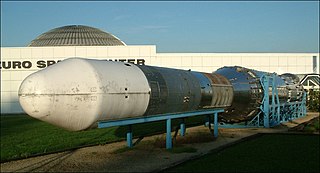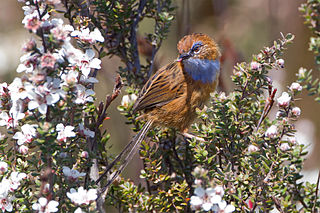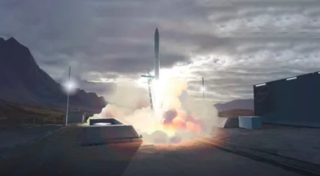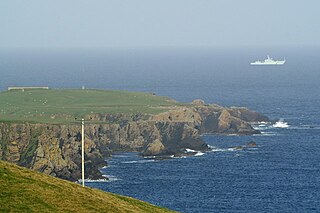
The European Launcher Development Organisation (ELDO) is a former European space research organisation. It was first developed in order to establish a satellite launch vehicle for Europe. The three-stage rocket developed was named Europa, after the mythical Greek goddess. Overall, there were 10 launches that occurred under ELDO's funding. The organisation consisted of Belgium, Britain, France, Germany, Italy, and the Netherlands. Australia was an associate member of the organisation.

The Pacific Spaceport Complex – Alaska (PSCA), formerly known as the Kodiak Launch Complex (KLC), is a dual-use commercial and military spaceport for sub-orbital and orbital launch vehicles. The facility is owned and operated by the Alaska Aerospace Corporation, a corporation owned by the Government of Alaska, and is located on Kodiak Island in Alaska.

This is a timeline of first orbital launches by country. While a number of countries, incl. Canada, Australia, Germany, Brazil, Algeria, Kazakhstan, Turkey, Argentina, Italy, Malaysia, Poland, South Africa, the Philippines, Egypt, Spain, Mexico, Thailand and Chile, have built or launched satellites, as of 2022, eleven countries, incl. the United States, Japan, China, India, Iran, Israel, France, the United Kingdom and South Korea, have had the capability to send objects into orbit with their own launch vehicles. Russia and Ukraine inherited the capability of the space launchers and satellites from the Soviet Union, following its dissolution in 1991. Russia launches its rockets from its own and foreign (Kazakh) spaceports.

The Mid-Atlantic Regional Spaceport (MARS) is a commercial space launch facility located at the southern tip of NASA's Wallops Flight Facility on Wallops Island in Virginia, just east of the Delmarva Peninsula and south of Chincoteague, Virginia, United States. It is owned and operated by the Virginia Spaceport Authority.

The southern emu-wren is a species of bird in the Australasian wren family, Maluridae. It is endemic to Australia. Its natural habitats are temperate forests, and Mediterranean-type shrubby vegetation, and swamplands.

The Port of Abbot Point is home to the North Queensland Export Terminal (NQXT), the most northerly deepwater coal port of Australia, situated approximately 25 kilometres (16 mi) north-west of the town of Bowen, Queensland. Established in 1984, it consists of a rail in-loading facility, coal handling and stockpile areas, and a single trestle jetty and conveyor connected to a berth and shiploader, located 2.75 km off-shore. Coal reaches the port via the GAP railway line from the Bowen Basin Coalfields.

Rocket Lab USA, Inc. is a publicly traded aerospace manufacturer and launch service provider. Its Electron orbital rockets launches small satellites, and has launched 53 times as of 2024. A sub-orbital Electron variant called HASTE serves other needs. The company also supplies satellite components including star trackers, reaction wheels, solar cells and arrays, satellite radios, separation systems, as well as flight and ground software.
Koonibba is a locality and an associated Aboriginal community in South Australia located about 586 kilometres (364 mi) northwest of the state capital of Adelaide and about 38 km (24 mi) northwest of the municipal seat in Ceduna and 5 km (3.1 mi) north of the Eyre Highway.

Rocket Lab Launch Complex 1 is a commercial spaceport located close to Ahuriri Point at the southern tip of Māhia Peninsula, on the east coast of New Zealand's North Island. It is owned and operated by private spaceflight company Rocket Lab and supports launches of the company's Electron rocket for small satellites. The facility officially opened on 26 September 2016 (UTC). With the launch of Electron on 25 May 2017, it became the first private spaceport to host an orbital launch attempt, and the first site in New Zealand to host an orbital launch attempt. With the Electron launch of 21 January 2018, it became the first private spaceport to host a successful orbital launch.

Gilmour Space Technologies is a venture-funded Australian aerospace company that is developing hybrid-propellant rocket engines and associated technologies to support the deployment of a low-cost launch vehicle.

The Sutherland spaceport, also known as Space Hub Sutherland or UK Vertical Launch (UKVL) Sutherland, is a planned spaceport to be located in Sutherland in Scotland. It would be the first vertical launch capable spaceport in the United Kingdom, and operated by a commercial entity. The spaceport is intended to support the Orbex Prime launch vehicle. The spaceport will be located on the A' Mhòine peninsula northwest of Tongue village, Sutherland, Scotland. Groundbreaking occurred on 5 May 2023.
Black Sky Aerospace (BSA) is an Australian private aerospace company, headquartered in Logan, Queensland. Black Sky Aerospace specialises in payload delivery systems using in-house developed propulsion technologies, rocket componentry and suborbital vehicles. Black Sky also provides access to calibration and simulation systems.
Whalers Way Orbital Launch Complex is a commercial spaceport and rocket-launching facility operated by Southern Launch in the locality of Sleaford, near Port Lincoln on the Eyre Peninsula of South Australia.

TiSPACE, officially Taiwan Innovative Space Inc., is a space launch company from Taiwan.
Koonibba is a locality and an Aboriginal community in South Australia.
Boca Chica is an area on the eastern portion of a subdelta peninsula of Cameron County, at the far south of the US State of Texas along the Gulf Coast. It is bordered by the Brownsville Ship Channel to the north, the Rio Grande and Mexico to the south, and the Gulf of Mexico to the east. The area extends about 25 miles (40 km) east of the city of Brownsville. The peninsula is served by Texas State Highway 4—also known as the Boca Chica Highway, or Boca Chica Boulevard within Brownsville city limits—which runs east–west, terminating at the Gulf and Boca Chica Beach.

The Koonibba Test Range is a rocket test range site near the township of Koonibba in the far west of South Australia. Rockets are launched to the north over a clear area – the Yumbarra Conservation Park and Yellabinna Wilderness Protection Area – for 145 kilometres (90 mi).

SaxaVord Spaceport, previously known as Shetland Space Centre, is a UK spaceport located on the Lamba Ness peninsula on Unst, the most northerly of the inhabited Shetland Islands off the coast of Scotland. The site is near the RAF Saxa Vord radar station and the settlement of Skaw, adjacent to the Saxa Vord distillery.
The Arnhem Space Centre is a commercial spaceport near Nhulunbuy, in Arnhem Land, Australia. The facility is owned and operated by Equatorial Launch Australia and was the location of NASA's first non-orbital sounding rocket launch from a commercial spaceport outside the United States, which took place on 27 June 2022.

HyImpulse is a German private space launch enterprise headquartered in Neuenstadt am Kocher and developing a small launch vehicle designed around hybrid-propellant rockets. The company is a DLR spinoff founded in 2018 out of the chemical propulsion center of the German space agency's Lampoldshausen facility. HyImpulse is bankrolled by Rudolf Schwarz, chairman of German technology company IABG.














